Unit 4 复习提升课件【大单元教学】人教版七年级英语上册Unit 4 Where's my schoolbag?
文档属性
| 名称 | Unit 4 复习提升课件【大单元教学】人教版七年级英语上册Unit 4 Where's my schoolbag? | 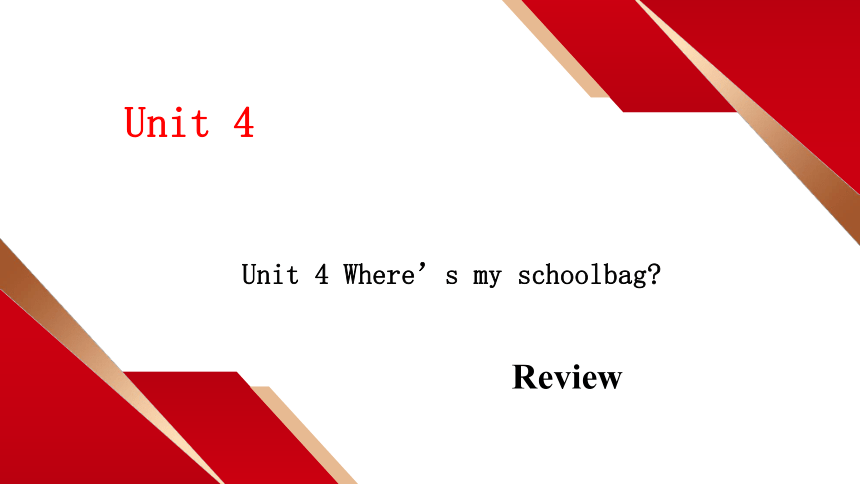 | |
| 格式 | pptx | ||
| 文件大小 | 2.7MB | ||
| 资源类型 | 试卷 | ||
| 版本资源 | 人教新目标(Go for it)版 | ||
| 科目 | 英语 | ||
| 更新时间 | 2023-09-08 11:33:58 | ||
图片预览

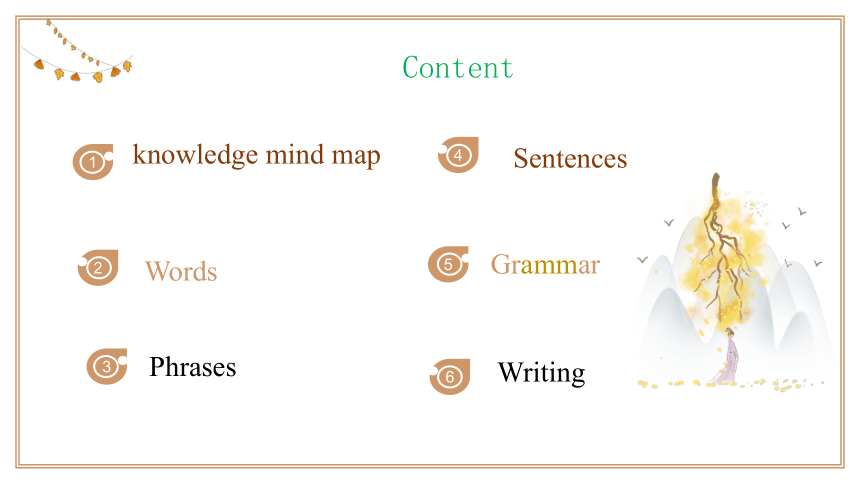
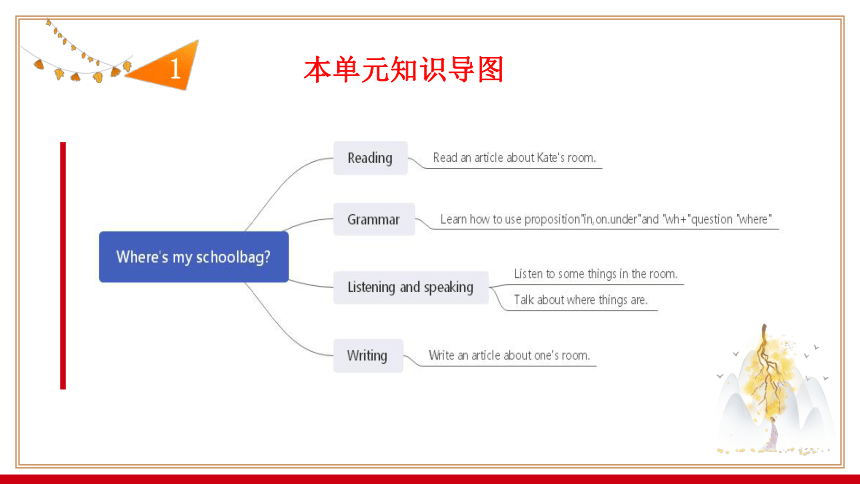
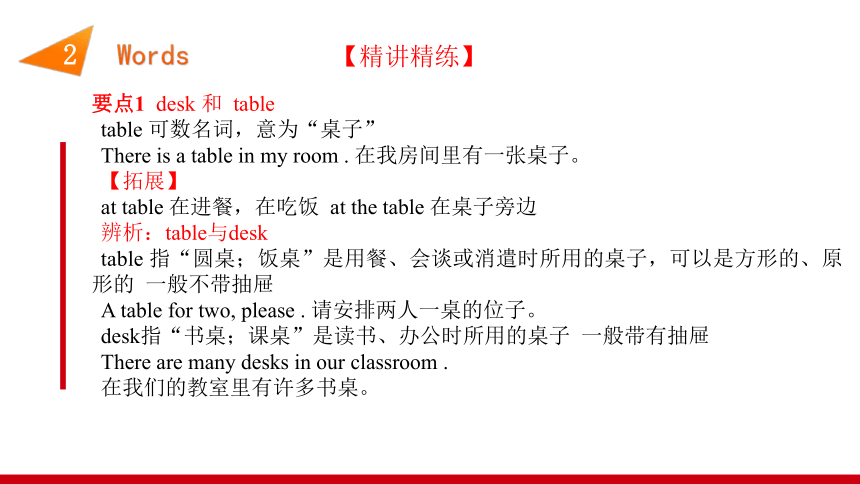
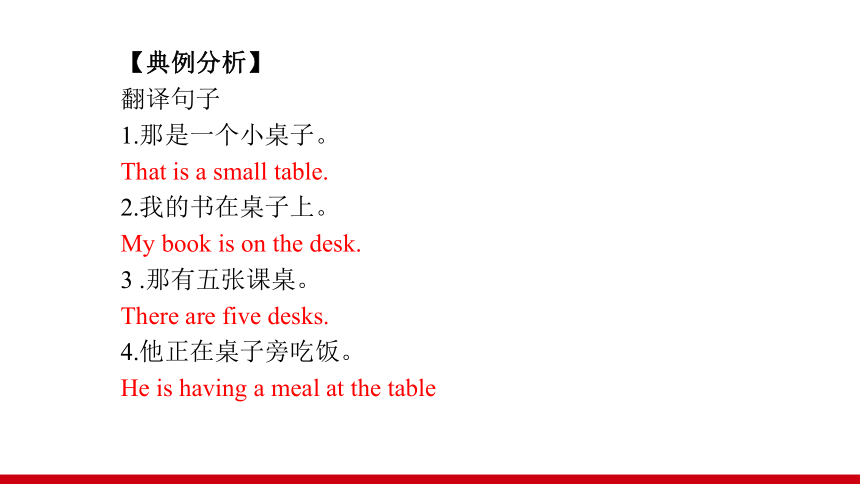
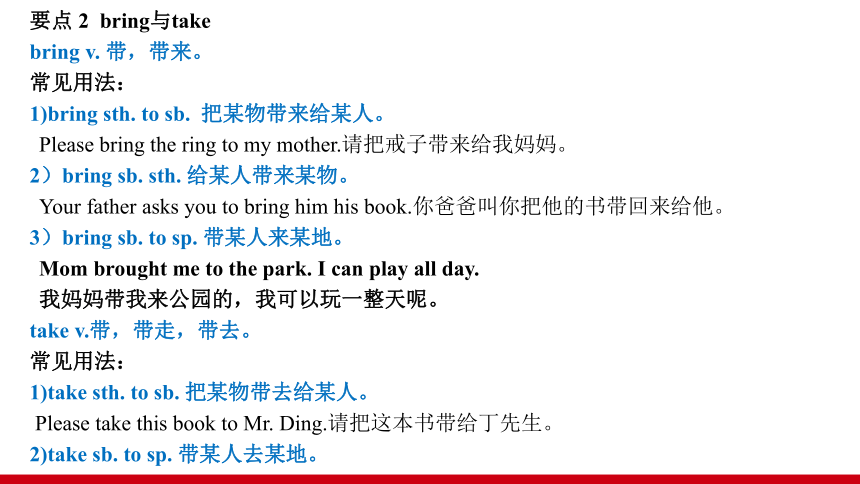
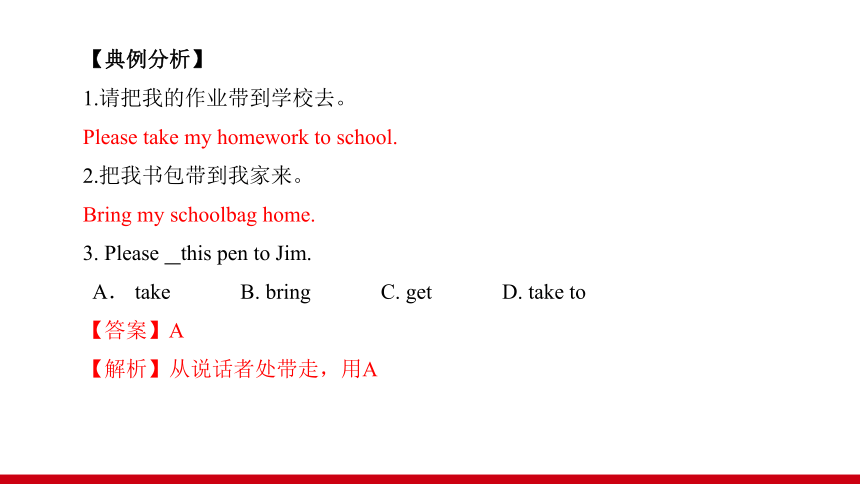
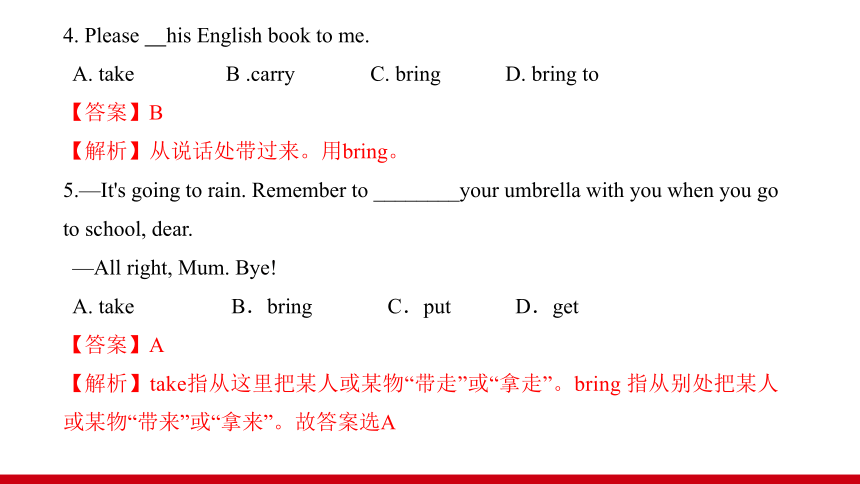
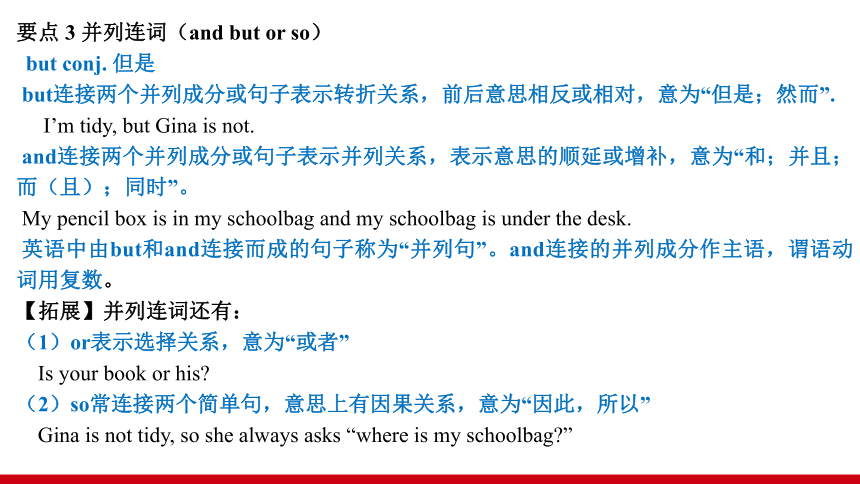
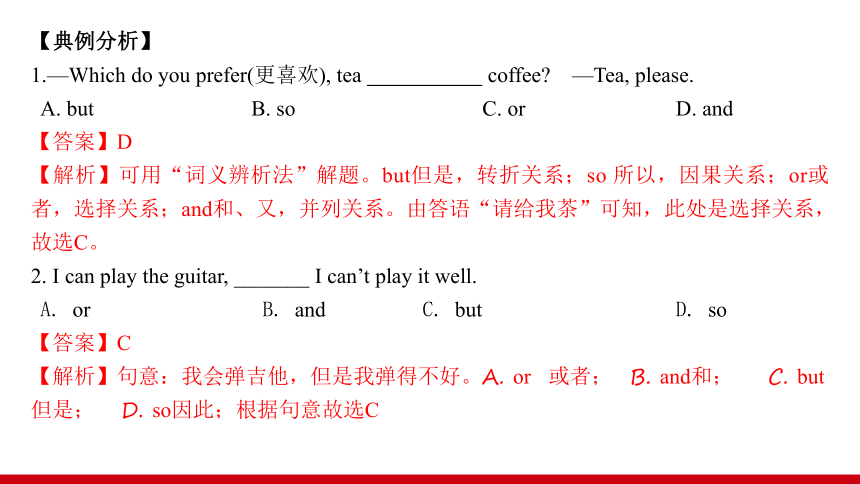
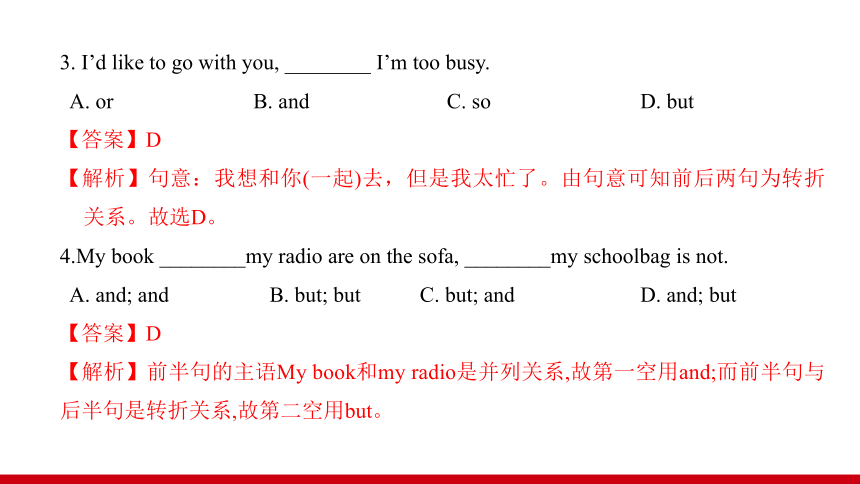
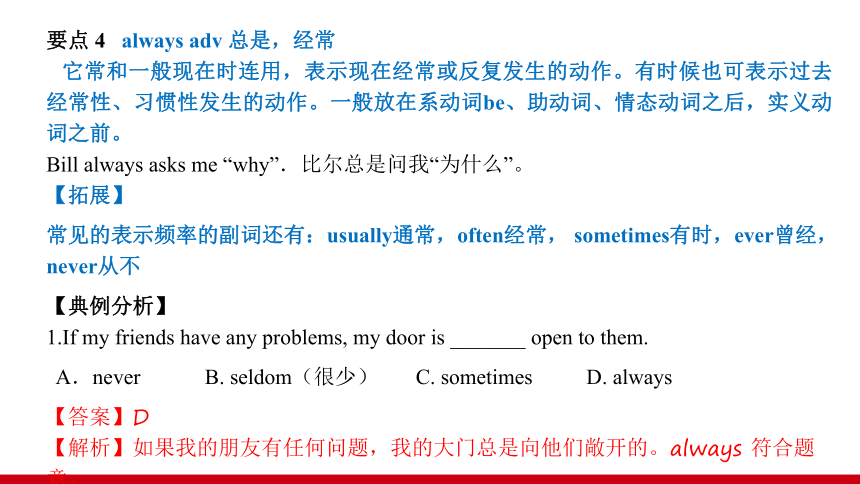
文档简介
(共49张PPT)
Unit 4
Review
Unit 4 Where’s my schoolbag
Words
1
Phrases
2
Sentences
3
4
Content
Writing
5
6
Grammar
knowledge mind map
本单元知识导图
1
Words
2
要点1 desk 和 table
table 可数名词,意为“桌子”
There is a table in my room . 在我房间里有一张桌子。
【拓展】
at table 在进餐,在吃饭 at the table 在桌子旁边
辨析:table与desk
table 指“圆桌;饭桌”是用餐、会谈或消遣时所用的桌子,可以是方形的、原形的 一般不带抽屉
A table for two, please . 请安排两人一桌的位子。
desk指“书桌;课桌”是读书、办公时所用的桌子 一般带有抽屉
There are many desks in our classroom .
在我们的教室里有许多书桌。
【精讲精练】
【典例分析】
翻译句子
1.那是一个小桌子。
That is a small table.
2.我的书在桌子上。
My book is on the desk.
3 .那有五张课桌。
There are five desks.
4.他正在桌子旁吃饭。
He is having a meal at the table
要点 2 bring与take
bring v. 带,带来。
常见用法:
1)bring sth. to sb. 把某物带来给某人。
Please bring the ring to my mother.请把戒子带来给我妈妈。
2)bring sb. sth. 给某人带来某物。
Your father asks you to bring him his book.你爸爸叫你把他的书带回来给他。
3)bring sb. to sp. 带某人来某地。
Mom brought me to the park. I can play all day.
我妈妈带我来公园的,我可以玩一整天呢。
take v.带,带走,带去。
常见用法:
1)take sth. to sb. 把某物带去给某人。
Please take this book to Mr. Ding.请把这本书带给丁先生。
2)take sb. to sp. 带某人去某地。
【典例分析】
1.请把我的作业带到学校去。
Please take my homework to school.
2.把我书包带到我家来。
Bring my schoolbag home.
3. Please this pen to Jim.
A. take B. bring C. get D. take to
【答案】A
【解析】从说话者处带走,用A
4. Please his English book to me.
A. take B .carry C. bring D. bring to
【答案】B
【解析】从说话处带过来。用bring。
5.—It's going to rain. Remember to ________your umbrella with you when you go to school, dear.
—All right, Mum. Bye!
A. take B.bring C.put D.get
【答案】A
【解析】take指从这里把某人或某物“带走”或“拿走”。bring 指从别处把某人或某物“带来”或“拿来”。故答案选A
要点 3 并列连词(and but or so)
but conj. 但是
but连接两个并列成分或句子表示转折关系,前后意思相反或相对,意为“但是;然而”.
I’m tidy, but Gina is not.
and连接两个并列成分或句子表示并列关系,表示意思的顺延或增补,意为“和;并且;而(且);同时”。
My pencil box is in my schoolbag and my schoolbag is under the desk.
英语中由but和and连接而成的句子称为“并列句”。and连接的并列成分作主语,谓语动词用复数。
【拓展】并列连词还有:
(1)or表示选择关系,意为“或者”
Is your book or his
(2)so常连接两个简单句,意思上有因果关系,意为“因此,所以”
Gina is not tidy, so she always asks “where is my schoolbag ”
【典例分析】
1.—Which do you prefer(更喜欢), tea coffee —Tea, please.
A. but B. so C. or D. and
【答案】D
【解析】可用“词义辨析法”解题。but但是,转折关系;so 所以,因果关系;or或者,选择关系;and和、又,并列关系。由答语“请给我茶”可知,此处是选择关系,故选C。
2. I can play the guitar, _______ I can’t play it well.
A. or B. and C. but D. so
【答案】C
【解析】句意:我会弹吉他,但是我弹得不好。A. or 或者; B. and和; C. but 但是; D. so因此;根据句意故选C
3. I’d like to go with you, ________ I’m too busy.
A. or B. and C. so D. but
【答案】D
【解析】句意:我想和你(一起)去,但是我太忙了。由句意可知前后两句为转折关系。故选D。
4.My book ________my radio are on the sofa, ________my schoolbag is not.
A. and; and B. but; but C. but; and D. and; but
【答案】D
【解析】前半句的主语My book和my radio是并列关系,故第一空用and;而前半句与后半句是转折关系,故第二空用but。
要点 4 always adv 总是,经常
它常和一般现在时连用,表示现在经常或反复发生的动作。有时候也可表示过去经常性、习惯性发生的动作。一般放在系动词be、助动词、情态动词之后,实义动词之前。
Bill always asks me “why”.比尔总是问我“为什么”。
【拓展】
常见的表示频率的副词还有:usually通常,often经常, sometimes有时,ever曾经,never从不
【典例分析】
1.If my friends have any problems, my door is _______ open to them.
A.never B. seldom(很少) C. sometimes D. always
【答案】D
【解析】如果我的朋友有任何问题,我的大门总是向他们敞开的。always 符合题意。
2. —Mike helps us with our problems.
—So, that’s why he is so welcome in your class.
A. always B. too C. very D. only
【答案】A
【解析】句意:——迈克总是帮助我们解决问题。——所以,这就是他在你们班上如此受欢迎的原因。
考查副词辨析。always总是;too太;very非常;only只有。根据“he is so welcome”证明他很受欢迎,那么他一定是“总是”帮助同学。用于主谓之间表示频率极高,作状语,故选A。
3.Grace ________ good at(擅长) English in our school.
A. is always B. always is C. are always D. always are
【答案】A
【解析】考查always 用法。Always用在“be”动词后面。“实义动词”前面。
要点 5 radio
radio 收音机 可数名词,意为“收音机”复数形式为radios。
My grandfather has two radios . 我爷爷有两台收音机。
【拓展】
以o结尾的名词变复数时,可以在词尾直接加-s的单词有:
zoo 动物园, kangaroo 袋鼠, bamboo竹子, photo照片, radio收音机,piano钢琴等。
助记:
袋鼠在动物园里一边观看竹子的照片,一边聆听收音机里的钢琴声。
【典例分析】
1.Here are some ______ of Linda's family.
A.photo B.photoes C.photos D.a photo
【答案】C
【解析】点拨:考查名词复数。由系动词are可知“不止一张照片”,排除A、D两项;photo的复数形式直接在词尾加-s,排除B项。故选C项。
2. He likes listening to ______every day, because he thinks the music in it is beautiful.
A. radio B. clock C. model D. plane
【答案】A
【解析】考查词语意思辨异。他每天喜欢听广播。因为他认为里面的音乐很美。Radio符合题意。
要点 6 clock
clock时钟 可数名词, 意为“时钟”
There is a clock on the wall . 墙上有一个时钟。
注意:
clock与o’clock在形式上只有很小的差别,但意义不同:clock的意思是“钟表”而o’clock的意思是“点钟”表示整点。如:five o’clock “5点钟”
辨析:clock与watch
clock指挂钟、闹钟或建在钟楼、钟塔上的钟表等。
watch 指手表、怀表或秒表等。
【典例分析】
1.He looks at the c_________ and knows he is late for(迟到) school again.
【答案】clock
要点7
come on 意思是“快点”,用来催促别人快走或快做。英语中还可以用Hurry (up)!表示催促。
Come on,it’s getting dark.快点儿,天要黑了。
【拓展】
come on的其他含义:
①. 用来表示请求、鼓励、劝说等,意为“来吧;行啦”。
Come on, Kate. Don’t be shy. 来吧,凯特。别害羞。
②.用于体育竞赛等场合鼓励队员,意为“加油”
“Come on! Come on! ”shouted the students. “加油!加油!”学生们大声喊道。
③. 用于挑战或激怒对方,意为“来吧;好吧;试试吧”。
Come on! I’m not afraid of you . 来吧!我不怕你。
④. 用于招呼别人,意为“来,过来”
Come on! This way ,please . 来!请走这边。
⑵. come不及物动词,意为“来;来到”反义词为go,意为“去”
Come to my house this Sunday, please . 这个星期天请来我家。
1. , boys! Let’s play volleyball.
A. Excuse me B. Thank you C. Come on D. It’s OK
【答案】C
【解析】句意:来吧,孩子们!让我们打排球吧。
考查情景交际。Excuse me请原谅我;Thank you谢谢你;Come on来吧;It’s OK没事的。根据“Let’s play volleyball.”可知是呼吁孩子们一起玩,即“来吧”。故选C。
2.______,boys;you can win(赢).
A.Come in B.Come to C.Come on D.Let's
【答案】C
【解析】点拨:根据句意“男孩们,加油啊,你们会赢的”可知,此处应选一个表示“加油”的短语,四个选项中只有come on有此意,故选C项。
要点8
I think..... 意为“我认为......”此结构用来表述自己的主观想法或对某物的看法;后面常接that引导的带有主谓结构的句子,在口语中that可省略。
I think( that)the keys are Alice’s .
我认为这些钥匙是艾利斯的。
注意:
1.I think....的否定形式为“I don’t think ....”意为“我认为.....不,,,,,”
I don’t think he is right . 我认为他不对。
2. think 动词,意为“认为;想;思考”
I think the baseball is Bill’s . 我认为这个棒球是比尔的。
【典例分析】
1. —Dad, is my tape player on the desk
—No, I it is on the table in your room.
A. help B. spell C. come D. think
【答案】D
【解析】句意:——爸爸,我的录音机在书桌上吗?——不,我想它在你房间的桌子上。考查动词辨析。help帮助;spell拼写;come来;think认为。根据no可知是“没有”在书桌上,此处是在是自己的想法。故选D。
2.—Where's the radio
—I _______ it's in your grandparents' room.
A. lose B. say C. think D. meet
【答案】C
【解析】lose丢失;say说(后直接跟内容);think认为;meet会面,遇见。问句意为"收音机在哪儿?",结合答句句意"我认为它在你(外)祖父母的房间里"。可知选C。
要点9
I don’t know.我不知道。
⑴. 对他人的询问或提出的问题,若不知道或不清楚时,常用I don’t know .回答。日常交际中,通常在前面加上sorry或I’m sorry, 这样显得礼貌、客气。
Where is my watch 我的手表在哪里?
I don’t know . 我不知道。
Where is Li Ping 李平在哪里?
Sorry, I don’t know . 对不起,我不知道。
know动词,意为“知道,了解”
He can sing . 他会唱歌。
Yes, I know . 是的,我知道。
I know their names. 我知道他们的名字。
【典例分析】
1.—Hey,Mike!Is Kate in the classroom —________.You can ask Cindy.
A.I don't know B.I see C.Have a good day D.Thanks for your help
【答案】A
【解析】句意:——嘿,迈克!凯特在教室里吗?——我不知道,你可以问辛迪。
考查情景交际。A. I don't know我不知道;B. I see我知道了;C. Have a good day祝你度过愉快的一天;D. Thanks for your help感谢你的帮助。根据答语可知,后者让前者去问Cindy,所以他不知道Kate是否在教室。故选A。
2.-Where is my key. Mom -______ Is it in your schoolbag
A.It's here B.It's on the floor C.Its under your bed D.1 don't know
【答案】D
【解析】句意:-妈妈,我的钥匙在哪里?-我不知道,它在你的书包里吗?It’s here.它在这儿;It’s on the floor.它在地板上;It’s under your bed.它在你的床底下;I don’t know.我不知道。根据下句话Is it in your schoolbag 可知,妈妈也不知道钥匙在哪里,所以才会用疑问句的形式。故应选D。
要点10
tidy 形容词,意为“整洁的;有条不紊的”既可放在连系动词的后面作表语,也可放在名词之前作定语。常见短语:keep tidy 意为“保持整洁”tidy的反义词为untidy, 意为“不整洁的,凌乱的”
The room is very tidy . 这个房间很整洁。
I like keeping tidy . 我喜欢保持整洁。
He is a tidy boy . 他是一个整洁的男孩。
John’s room is very untidy . 约翰的房间非常乱。
【拓展】
Tidy作动词,意为“使整洁”后面可接名词或代词作宾语。
Tidy your room, Tom . 汤姆,收拾好你的房间。
【典例分析】
1. Peter’s room is not ________. His balls are everywhere.
A. good B. fine C. tidy D. nice
【答案】 C
【解析】句意:彼得的房间不整洁。他的球丢得到处都是。东西放得乱七八糟,应该是不够整洁,用tidy。
2.Li's room is not ___. His books are everywhere, on his bed, on the sofa and under the chair.
A. funny B. big C. tidy D. old
【答案】C
【解析】考查形容词辨析。句意:李的房间不整洁。他的书到处都是,在他的床上、沙发上和椅子下面。funny有趣的,滑稽的;big大的;tidy整洁的;old老的。根据"His books are everywhere,on his bed,on the sofa and under the chair."可知,李的房间不整洁。故选C。
要点11
everywhere 副词,意为“处处;到处;各个地方”相当于here and there .
In spring, we can see flowers everywhere .
在春天,我们到处都能看到花。
The balls are everywhere . 球到处都是。
【典例分析】
1.根据首字母及汉语提示,完成单词的拼写。
We shouldn’t throw rubbish e________ (到处)to protect the environment .
【答案】everywhere
2.This is Gina’s room. Her books are ________everywhere.
A.in B. on C.at D./
【答案】D
【解析】句意: 这是吉娜的房间。她的书到处都是。everywhere是地点副词,前面不用介词。
3.It is a world of flowers in Spring in Dongying. You can see flowers ______.
A. here B. there C. somewhere D. everywhere
【答案】D
【解析】here这儿;there那儿;somewhere某个地方; everywhere处处。由语境可知选D。
要点12
1.方位介词用法
(1)In 表示在……的里面。
如:in the class;in the desk. 注意:在书上,在图画上,虽然我们中文说的是“上”,但英文表达中都需要用 in the book;in the picture.
(2).On 表示在……的上面;通常是与物体接触的上面。
如:on the desk;on the table.
(3).behind 表示在……的后面。
如: behind the door;behind the wall,指的是在整个物体的后面,有时有藏在后面的意思。 如果指在物体内部的后面,表示在……的后部,则不用这个词。
(4).In front of / in the front of表示在……的前面。
注意:加the的短语表示在一个物体内部的前面。
如:he teacher is teaching in the front of the classroom.
(5)in the tree/ on the tree都可以表示在树上。
但如果是长在树上的东西,用介词on,而如果不是树上本身长的东西则用in。
如:There is an apple on the tree. There is a bird in the tree.
(6)under 表示在某物垂直的正下方,两者之间不接触。
例如: under the tree 在树下 under the chair 在椅子下
(7)with 的用法
“与…在一起”,“和 ”,“ with sb ” 意为“和某人在一起”,表示伴随。
具有(……的品质或特征),其后接名词构成介词短语,常作定语。
一、用on, in或under填空
1.—Where is my schoolbag, Mom
—It’s your grandparents’ room.
2.Linda’s English book is the desk, the floor(地板).
3.Some birds(鸟) are the tree(树).
4.My computer is my desk.
5.My bike is the tree.
6.There are some apples the tree.
7.A cat is the bed.
8.There is a map the wall.
9.My dictionary is the bookcase.
10.My pencil box is the chair.
【答案】1.in 2.under on 3.in 4.on 5.under 6.on 7.on 8.on 9.in 10.on/under
二、根据后面汉语提示填写方位词
1.My books are _______the table. 我的书在桌子上。
【答案】on。表示在……的上面;通常是与物体接触的上面。
2.My pen is __________the bag. 我的笔在包里。
【答案】in In 表示在……的里面。
3.There are some trees _______________our classroom. 我们教室前面有一些树。
【答案】In front of表示在……的前面(外部)。
4.There is a cat _________the door. 门后面有一只猫。
【答案】behind表示在……的后面。
5. My pencil is __________my pencil box. 我的铅笔在我的铅笔盒里。
【答案】in In 表示在……的里面。
6.There is an English book _________my bed.在我的床上有一本英语书。
【答案】on 表示在……的上面;通常是与物体接触的上面。
7. My basketball is _________ the bed. 我的篮球在床底下。
【答案】under under 表示在某物垂直的正下方,两者之间不接触。
Phrases
3
1. 我的铅笔盒
2. 在沙发上
3. 在你的书包里
4. 在你的床底下
5. 在你祖父母的房间里
6. 一个飞机模型
7. 在书柜里
8. 在收音机下面
9.在讲台上
10. 在你头上
my pencil box
on the sofa
in your schoolbag
under your bed
in your grandparents’ room
a model plane
in the bookcase
under the radio
on the teacher’s desk
on your head
Sentences
4
1.—Where’s the schoolbag 书包在哪里
— I t ’s under the table. 在餐桌下。
2.— Where are my books?我的书在哪里?
—They’re on the sofa. 在沙发上。
3.Where is your ruler
你的尺子在哪里?
4.—Where’s my bag 我的包在哪里?
—Is it on your desk 在你的书桌上吗?
5.It’s not under the chair.
它不在椅子下面。
6.I think it ’s in your grandparents’ room.
我想它在你祖父母的房间里。
7.I‘m tidy,but Gina is not.
我(东西放得)整齐,但吉娜不整齐。
8.I have a clock.
我有一台钟。
9.Gina’s books are everywhere.
吉娜的书到处乱放。
Grammar
5
一、介词in on under用法
介词一般用于名词或代词前,表示该词与句子其他成分的关系(如位置关系)。介词后面的名词或代词称为介词宾语。介词和介词宾语一起构成介词短语。
1) in prep. “在……里”,常用于:
(1)表示方位,“在……里(上)”。此时注意in the tree与on the tree的区别,长在树上用on,外来的用in。
The bird is in the tree.
There are some apples on the tree.
(2)表示时间,用在表示年、月、世纪、年代、早上、下午、晚上等的名词前。
We are in 2013 now. 我们现在在2021年。
(3)表示地点,用在表示地点(如城市、乡村、国家)的名词前。
She is in Shanghai. 她在上海。
(4)表示用某种语言。
What’s this in English
(5)表示穿着、带着。
Who’s the boy in blue 穿蓝色衣服的男孩是谁?
(6)in the picture/newspaper“在图片/报纸上”,表示是图片或报纸的内容。
The girl in the picture is beautiful.
图片上的那个女孩很漂亮。
on prep.
(1)“在……上面”,强调某物在另一物的表面上。
The pen is on the desk.钢笔在桌子上。
(2)在具体的某一天,某一天的上午,下午,晚上用on
under
under prep. “在……下”,其后接名词或代词构成介词短语,用来表示人或物的位置。
Look!An apple is under the table.
补充:under prep.低于;少于.
The watch is under 50 yuan.这块表低于50元。
on the bed和in bed
他的爷爷躺在床上。His grandpa is in bed.
我的包在床上。My bag is on the bed.
(说明:物品在床上要用介词on,bed前要用冠词,或其他限定词,特指在那张床上。若表示人躺在床上要用介词in,而且bed前无任何限定词)
二、where引导的特殊疑问句
where引导的特殊疑问句用来询问某人或某物的位置,构成“Where+be+主语?”形式。be动词的选择取决于其后的主语,单数is,复数are。“Where is/are...?”句型的答语要根据主语单复数的不同分别用“It’s...”或“They’re...”,有时直接说出物品所在地点,省略it’s或they’re。
—Where is his book 他的书在哪儿?
—It’s in his schoolbag.它在他的书包里。
—Where are your pencils 你的铅笔在哪儿?
—They’re on the desk.在课桌上。
—Where’s the picture 图画在哪儿?
—On the wall.在墙上。
注意:当我们确认物体的位置,询问“某物是否在某地”时,常用到一个一般疑问句,其结构为“Is/Are+主语(人/物)+表示方位的介词短语?”此句型用yes或no作答。
—Is your pen in the pencil box 你的钢笔在铅笔盒里吗?
—No,it isn’t.不,它不在。
—Are your keys on the desk 你的钥匙在桌子上吗?
—Yes,they are.是的,它们在。
【典例分析】
1.—______ is my skirt
—It's behind the door.
A.Where B.What C.Whose D.Which
【答案】A
【解析】点拨:考查疑问词。A项意为“在哪里”;B项意为“什么”;C项意为“谁的”;D项意为“哪一个”。由答语“It's behind the door.(它在门后。)”可知是询问地点。故应选A 项。
2. —Where are his pencils
—________.
A. Yes, they are B. It’s on the desk C. In the pencil box D. No, they aren’t
【答案】C
【解析】问句为特殊疑问句,不能用 yes回答,排除A、D选项。询问的是复数名词,代词该用they,不用it。故B也不正确。故选C
3. —________
—They are on the floor.
A. Where is my baseball B. Where are my baseballs
C. Is the baseball on the floor D. Are the baseballs on the floor
【答案】 B
【解析】考查问答语的统一。由答语"They are on the floor."可知询问物品所在的位置,并且由are可知选B。
Writing
6
本单元写作要求同学们能简单介绍自己的家、卧室等场所,内容包括物品的特点及位置。
1.能用in,on,under 等方位介词表达物品所在的位置;
2.能正确地使用连词and,but连接短语和句子
一、词汇积累
(一)把下列短语译成英语。
1.一本英语字典 ________________
2.两本红色的笔记本 ________________
3.一串钥匙 ________________
4.一只蓝色手表 ________________
5.在床下面 ________________
6.在书橱里 ________________
7.一个黑色飞机模型 ________________
8.我的时钟 ________________
9.在铅笔盒里 ________________
10.在沙发下面 ________________
an English dictionary
two red notebooks
a set of keys
a blue watch
under the bed
in the bookcase
a black model plane
my clock
in the pencil box
under the sofa
(二)把下列短语译成汉语。
1.Tom's tape player ________________
2.our room ________________
3.her purple hat ________________
4.under the chair ________________
5.on the table ________________
6.six white cups ________________
7.your baseball ________________
8.Paul's ID card ________________
汤姆的录音机
我们的房间
她的紫色帽子
在椅子下面
在桌子上
六个白色的杯子
你的棒球
保罗的身份证/学生卡
二、句子积累
1.那把白色的尺子是她的。
2.两台收音机在桌子上吗?
3.我的地图不在书柜里。
4.我认为它不在书包里。
5.——你的铅笔在哪儿? ——它们在铅笔盒里。
Where are your pencils They are in the pencil box.
That white ruler is hers.
Are two radios on the desk/table?
My maps aren't (map isn't)in the bookcase.
I don't think it is in the schoolbag.
6. 我的文具盒和书在书柜里吗?
7. ——他的书包在教室里吗? ——我不知道。
8. 我的夹克衫在床上,但我的帽子不在。
9. Andy,快点儿!
10. 书桌下的橡皮是你的吗?
Are my pencil box and book(s) in the bookcase
Is his schoolbag in the classroom —I don't know.
My jacket is on the bed, but my hat isn't.
Andy, come on!
Is the eraser under the desk yours
【实战演练】
假设下图是你的房间,请根据图片提示,描述一下房间内物品的位置。
要求:语句通顺,不少于60词。
参考词汇:football(足球)
This is my room. There is a bed, a table, a desk and a chair in my room. My quilt and my hat are on the bed. A book and a clock are on the table. My schoolbag is on the desk, and my pencil box is on the desk, too. Where is my football Oh! It's under the chair. I clean my room every day, so my room is very tidy and clean. I love my room very much!
全力以赴,绽放未来
Go All Out, Bloom the Future
谢
谢
Unit 4
Review
Unit 4 Where’s my schoolbag
Words
1
Phrases
2
Sentences
3
4
Content
Writing
5
6
Grammar
knowledge mind map
本单元知识导图
1
Words
2
要点1 desk 和 table
table 可数名词,意为“桌子”
There is a table in my room . 在我房间里有一张桌子。
【拓展】
at table 在进餐,在吃饭 at the table 在桌子旁边
辨析:table与desk
table 指“圆桌;饭桌”是用餐、会谈或消遣时所用的桌子,可以是方形的、原形的 一般不带抽屉
A table for two, please . 请安排两人一桌的位子。
desk指“书桌;课桌”是读书、办公时所用的桌子 一般带有抽屉
There are many desks in our classroom .
在我们的教室里有许多书桌。
【精讲精练】
【典例分析】
翻译句子
1.那是一个小桌子。
That is a small table.
2.我的书在桌子上。
My book is on the desk.
3 .那有五张课桌。
There are five desks.
4.他正在桌子旁吃饭。
He is having a meal at the table
要点 2 bring与take
bring v. 带,带来。
常见用法:
1)bring sth. to sb. 把某物带来给某人。
Please bring the ring to my mother.请把戒子带来给我妈妈。
2)bring sb. sth. 给某人带来某物。
Your father asks you to bring him his book.你爸爸叫你把他的书带回来给他。
3)bring sb. to sp. 带某人来某地。
Mom brought me to the park. I can play all day.
我妈妈带我来公园的,我可以玩一整天呢。
take v.带,带走,带去。
常见用法:
1)take sth. to sb. 把某物带去给某人。
Please take this book to Mr. Ding.请把这本书带给丁先生。
2)take sb. to sp. 带某人去某地。
【典例分析】
1.请把我的作业带到学校去。
Please take my homework to school.
2.把我书包带到我家来。
Bring my schoolbag home.
3. Please this pen to Jim.
A. take B. bring C. get D. take to
【答案】A
【解析】从说话者处带走,用A
4. Please his English book to me.
A. take B .carry C. bring D. bring to
【答案】B
【解析】从说话处带过来。用bring。
5.—It's going to rain. Remember to ________your umbrella with you when you go to school, dear.
—All right, Mum. Bye!
A. take B.bring C.put D.get
【答案】A
【解析】take指从这里把某人或某物“带走”或“拿走”。bring 指从别处把某人或某物“带来”或“拿来”。故答案选A
要点 3 并列连词(and but or so)
but conj. 但是
but连接两个并列成分或句子表示转折关系,前后意思相反或相对,意为“但是;然而”.
I’m tidy, but Gina is not.
and连接两个并列成分或句子表示并列关系,表示意思的顺延或增补,意为“和;并且;而(且);同时”。
My pencil box is in my schoolbag and my schoolbag is under the desk.
英语中由but和and连接而成的句子称为“并列句”。and连接的并列成分作主语,谓语动词用复数。
【拓展】并列连词还有:
(1)or表示选择关系,意为“或者”
Is your book or his
(2)so常连接两个简单句,意思上有因果关系,意为“因此,所以”
Gina is not tidy, so she always asks “where is my schoolbag ”
【典例分析】
1.—Which do you prefer(更喜欢), tea coffee —Tea, please.
A. but B. so C. or D. and
【答案】D
【解析】可用“词义辨析法”解题。but但是,转折关系;so 所以,因果关系;or或者,选择关系;and和、又,并列关系。由答语“请给我茶”可知,此处是选择关系,故选C。
2. I can play the guitar, _______ I can’t play it well.
A. or B. and C. but D. so
【答案】C
【解析】句意:我会弹吉他,但是我弹得不好。A. or 或者; B. and和; C. but 但是; D. so因此;根据句意故选C
3. I’d like to go with you, ________ I’m too busy.
A. or B. and C. so D. but
【答案】D
【解析】句意:我想和你(一起)去,但是我太忙了。由句意可知前后两句为转折关系。故选D。
4.My book ________my radio are on the sofa, ________my schoolbag is not.
A. and; and B. but; but C. but; and D. and; but
【答案】D
【解析】前半句的主语My book和my radio是并列关系,故第一空用and;而前半句与后半句是转折关系,故第二空用but。
要点 4 always adv 总是,经常
它常和一般现在时连用,表示现在经常或反复发生的动作。有时候也可表示过去经常性、习惯性发生的动作。一般放在系动词be、助动词、情态动词之后,实义动词之前。
Bill always asks me “why”.比尔总是问我“为什么”。
【拓展】
常见的表示频率的副词还有:usually通常,often经常, sometimes有时,ever曾经,never从不
【典例分析】
1.If my friends have any problems, my door is _______ open to them.
A.never B. seldom(很少) C. sometimes D. always
【答案】D
【解析】如果我的朋友有任何问题,我的大门总是向他们敞开的。always 符合题意。
2. —Mike helps us with our problems.
—So, that’s why he is so welcome in your class.
A. always B. too C. very D. only
【答案】A
【解析】句意:——迈克总是帮助我们解决问题。——所以,这就是他在你们班上如此受欢迎的原因。
考查副词辨析。always总是;too太;very非常;only只有。根据“he is so welcome”证明他很受欢迎,那么他一定是“总是”帮助同学。用于主谓之间表示频率极高,作状语,故选A。
3.Grace ________ good at(擅长) English in our school.
A. is always B. always is C. are always D. always are
【答案】A
【解析】考查always 用法。Always用在“be”动词后面。“实义动词”前面。
要点 5 radio
radio 收音机 可数名词,意为“收音机”复数形式为radios。
My grandfather has two radios . 我爷爷有两台收音机。
【拓展】
以o结尾的名词变复数时,可以在词尾直接加-s的单词有:
zoo 动物园, kangaroo 袋鼠, bamboo竹子, photo照片, radio收音机,piano钢琴等。
助记:
袋鼠在动物园里一边观看竹子的照片,一边聆听收音机里的钢琴声。
【典例分析】
1.Here are some ______ of Linda's family.
A.photo B.photoes C.photos D.a photo
【答案】C
【解析】点拨:考查名词复数。由系动词are可知“不止一张照片”,排除A、D两项;photo的复数形式直接在词尾加-s,排除B项。故选C项。
2. He likes listening to ______every day, because he thinks the music in it is beautiful.
A. radio B. clock C. model D. plane
【答案】A
【解析】考查词语意思辨异。他每天喜欢听广播。因为他认为里面的音乐很美。Radio符合题意。
要点 6 clock
clock时钟 可数名词, 意为“时钟”
There is a clock on the wall . 墙上有一个时钟。
注意:
clock与o’clock在形式上只有很小的差别,但意义不同:clock的意思是“钟表”而o’clock的意思是“点钟”表示整点。如:five o’clock “5点钟”
辨析:clock与watch
clock指挂钟、闹钟或建在钟楼、钟塔上的钟表等。
watch 指手表、怀表或秒表等。
【典例分析】
1.He looks at the c_________ and knows he is late for(迟到) school again.
【答案】clock
要点7
come on 意思是“快点”,用来催促别人快走或快做。英语中还可以用Hurry (up)!表示催促。
Come on,it’s getting dark.快点儿,天要黑了。
【拓展】
come on的其他含义:
①. 用来表示请求、鼓励、劝说等,意为“来吧;行啦”。
Come on, Kate. Don’t be shy. 来吧,凯特。别害羞。
②.用于体育竞赛等场合鼓励队员,意为“加油”
“Come on! Come on! ”shouted the students. “加油!加油!”学生们大声喊道。
③. 用于挑战或激怒对方,意为“来吧;好吧;试试吧”。
Come on! I’m not afraid of you . 来吧!我不怕你。
④. 用于招呼别人,意为“来,过来”
Come on! This way ,please . 来!请走这边。
⑵. come不及物动词,意为“来;来到”反义词为go,意为“去”
Come to my house this Sunday, please . 这个星期天请来我家。
1. , boys! Let’s play volleyball.
A. Excuse me B. Thank you C. Come on D. It’s OK
【答案】C
【解析】句意:来吧,孩子们!让我们打排球吧。
考查情景交际。Excuse me请原谅我;Thank you谢谢你;Come on来吧;It’s OK没事的。根据“Let’s play volleyball.”可知是呼吁孩子们一起玩,即“来吧”。故选C。
2.______,boys;you can win(赢).
A.Come in B.Come to C.Come on D.Let's
【答案】C
【解析】点拨:根据句意“男孩们,加油啊,你们会赢的”可知,此处应选一个表示“加油”的短语,四个选项中只有come on有此意,故选C项。
要点8
I think..... 意为“我认为......”此结构用来表述自己的主观想法或对某物的看法;后面常接that引导的带有主谓结构的句子,在口语中that可省略。
I think( that)the keys are Alice’s .
我认为这些钥匙是艾利斯的。
注意:
1.I think....的否定形式为“I don’t think ....”意为“我认为.....不,,,,,”
I don’t think he is right . 我认为他不对。
2. think 动词,意为“认为;想;思考”
I think the baseball is Bill’s . 我认为这个棒球是比尔的。
【典例分析】
1. —Dad, is my tape player on the desk
—No, I it is on the table in your room.
A. help B. spell C. come D. think
【答案】D
【解析】句意:——爸爸,我的录音机在书桌上吗?——不,我想它在你房间的桌子上。考查动词辨析。help帮助;spell拼写;come来;think认为。根据no可知是“没有”在书桌上,此处是在是自己的想法。故选D。
2.—Where's the radio
—I _______ it's in your grandparents' room.
A. lose B. say C. think D. meet
【答案】C
【解析】lose丢失;say说(后直接跟内容);think认为;meet会面,遇见。问句意为"收音机在哪儿?",结合答句句意"我认为它在你(外)祖父母的房间里"。可知选C。
要点9
I don’t know.我不知道。
⑴. 对他人的询问或提出的问题,若不知道或不清楚时,常用I don’t know .回答。日常交际中,通常在前面加上sorry或I’m sorry, 这样显得礼貌、客气。
Where is my watch 我的手表在哪里?
I don’t know . 我不知道。
Where is Li Ping 李平在哪里?
Sorry, I don’t know . 对不起,我不知道。
know动词,意为“知道,了解”
He can sing . 他会唱歌。
Yes, I know . 是的,我知道。
I know their names. 我知道他们的名字。
【典例分析】
1.—Hey,Mike!Is Kate in the classroom —________.You can ask Cindy.
A.I don't know B.I see C.Have a good day D.Thanks for your help
【答案】A
【解析】句意:——嘿,迈克!凯特在教室里吗?——我不知道,你可以问辛迪。
考查情景交际。A. I don't know我不知道;B. I see我知道了;C. Have a good day祝你度过愉快的一天;D. Thanks for your help感谢你的帮助。根据答语可知,后者让前者去问Cindy,所以他不知道Kate是否在教室。故选A。
2.-Where is my key. Mom -______ Is it in your schoolbag
A.It's here B.It's on the floor C.Its under your bed D.1 don't know
【答案】D
【解析】句意:-妈妈,我的钥匙在哪里?-我不知道,它在你的书包里吗?It’s here.它在这儿;It’s on the floor.它在地板上;It’s under your bed.它在你的床底下;I don’t know.我不知道。根据下句话Is it in your schoolbag 可知,妈妈也不知道钥匙在哪里,所以才会用疑问句的形式。故应选D。
要点10
tidy 形容词,意为“整洁的;有条不紊的”既可放在连系动词的后面作表语,也可放在名词之前作定语。常见短语:keep tidy 意为“保持整洁”tidy的反义词为untidy, 意为“不整洁的,凌乱的”
The room is very tidy . 这个房间很整洁。
I like keeping tidy . 我喜欢保持整洁。
He is a tidy boy . 他是一个整洁的男孩。
John’s room is very untidy . 约翰的房间非常乱。
【拓展】
Tidy作动词,意为“使整洁”后面可接名词或代词作宾语。
Tidy your room, Tom . 汤姆,收拾好你的房间。
【典例分析】
1. Peter’s room is not ________. His balls are everywhere.
A. good B. fine C. tidy D. nice
【答案】 C
【解析】句意:彼得的房间不整洁。他的球丢得到处都是。东西放得乱七八糟,应该是不够整洁,用tidy。
2.Li's room is not ___. His books are everywhere, on his bed, on the sofa and under the chair.
A. funny B. big C. tidy D. old
【答案】C
【解析】考查形容词辨析。句意:李的房间不整洁。他的书到处都是,在他的床上、沙发上和椅子下面。funny有趣的,滑稽的;big大的;tidy整洁的;old老的。根据"His books are everywhere,on his bed,on the sofa and under the chair."可知,李的房间不整洁。故选C。
要点11
everywhere 副词,意为“处处;到处;各个地方”相当于here and there .
In spring, we can see flowers everywhere .
在春天,我们到处都能看到花。
The balls are everywhere . 球到处都是。
【典例分析】
1.根据首字母及汉语提示,完成单词的拼写。
We shouldn’t throw rubbish e________ (到处)to protect the environment .
【答案】everywhere
2.This is Gina’s room. Her books are ________everywhere.
A.in B. on C.at D./
【答案】D
【解析】句意: 这是吉娜的房间。她的书到处都是。everywhere是地点副词,前面不用介词。
3.It is a world of flowers in Spring in Dongying. You can see flowers ______.
A. here B. there C. somewhere D. everywhere
【答案】D
【解析】here这儿;there那儿;somewhere某个地方; everywhere处处。由语境可知选D。
要点12
1.方位介词用法
(1)In 表示在……的里面。
如:in the class;in the desk. 注意:在书上,在图画上,虽然我们中文说的是“上”,但英文表达中都需要用 in the book;in the picture.
(2).On 表示在……的上面;通常是与物体接触的上面。
如:on the desk;on the table.
(3).behind 表示在……的后面。
如: behind the door;behind the wall,指的是在整个物体的后面,有时有藏在后面的意思。 如果指在物体内部的后面,表示在……的后部,则不用这个词。
(4).In front of / in the front of表示在……的前面。
注意:加the的短语表示在一个物体内部的前面。
如:he teacher is teaching in the front of the classroom.
(5)in the tree/ on the tree都可以表示在树上。
但如果是长在树上的东西,用介词on,而如果不是树上本身长的东西则用in。
如:There is an apple on the tree. There is a bird in the tree.
(6)under 表示在某物垂直的正下方,两者之间不接触。
例如: under the tree 在树下 under the chair 在椅子下
(7)with 的用法
“与…在一起”,“和 ”,“ with sb ” 意为“和某人在一起”,表示伴随。
具有(……的品质或特征),其后接名词构成介词短语,常作定语。
一、用on, in或under填空
1.—Where is my schoolbag, Mom
—It’s your grandparents’ room.
2.Linda’s English book is the desk, the floor(地板).
3.Some birds(鸟) are the tree(树).
4.My computer is my desk.
5.My bike is the tree.
6.There are some apples the tree.
7.A cat is the bed.
8.There is a map the wall.
9.My dictionary is the bookcase.
10.My pencil box is the chair.
【答案】1.in 2.under on 3.in 4.on 5.under 6.on 7.on 8.on 9.in 10.on/under
二、根据后面汉语提示填写方位词
1.My books are _______the table. 我的书在桌子上。
【答案】on。表示在……的上面;通常是与物体接触的上面。
2.My pen is __________the bag. 我的笔在包里。
【答案】in In 表示在……的里面。
3.There are some trees _______________our classroom. 我们教室前面有一些树。
【答案】In front of表示在……的前面(外部)。
4.There is a cat _________the door. 门后面有一只猫。
【答案】behind表示在……的后面。
5. My pencil is __________my pencil box. 我的铅笔在我的铅笔盒里。
【答案】in In 表示在……的里面。
6.There is an English book _________my bed.在我的床上有一本英语书。
【答案】on 表示在……的上面;通常是与物体接触的上面。
7. My basketball is _________ the bed. 我的篮球在床底下。
【答案】under under 表示在某物垂直的正下方,两者之间不接触。
Phrases
3
1. 我的铅笔盒
2. 在沙发上
3. 在你的书包里
4. 在你的床底下
5. 在你祖父母的房间里
6. 一个飞机模型
7. 在书柜里
8. 在收音机下面
9.在讲台上
10. 在你头上
my pencil box
on the sofa
in your schoolbag
under your bed
in your grandparents’ room
a model plane
in the bookcase
under the radio
on the teacher’s desk
on your head
Sentences
4
1.—Where’s the schoolbag 书包在哪里
— I t ’s under the table. 在餐桌下。
2.— Where are my books?我的书在哪里?
—They’re on the sofa. 在沙发上。
3.Where is your ruler
你的尺子在哪里?
4.—Where’s my bag 我的包在哪里?
—Is it on your desk 在你的书桌上吗?
5.It’s not under the chair.
它不在椅子下面。
6.I think it ’s in your grandparents’ room.
我想它在你祖父母的房间里。
7.I‘m tidy,but Gina is not.
我(东西放得)整齐,但吉娜不整齐。
8.I have a clock.
我有一台钟。
9.Gina’s books are everywhere.
吉娜的书到处乱放。
Grammar
5
一、介词in on under用法
介词一般用于名词或代词前,表示该词与句子其他成分的关系(如位置关系)。介词后面的名词或代词称为介词宾语。介词和介词宾语一起构成介词短语。
1) in prep. “在……里”,常用于:
(1)表示方位,“在……里(上)”。此时注意in the tree与on the tree的区别,长在树上用on,外来的用in。
The bird is in the tree.
There are some apples on the tree.
(2)表示时间,用在表示年、月、世纪、年代、早上、下午、晚上等的名词前。
We are in 2013 now. 我们现在在2021年。
(3)表示地点,用在表示地点(如城市、乡村、国家)的名词前。
She is in Shanghai. 她在上海。
(4)表示用某种语言。
What’s this in English
(5)表示穿着、带着。
Who’s the boy in blue 穿蓝色衣服的男孩是谁?
(6)in the picture/newspaper“在图片/报纸上”,表示是图片或报纸的内容。
The girl in the picture is beautiful.
图片上的那个女孩很漂亮。
on prep.
(1)“在……上面”,强调某物在另一物的表面上。
The pen is on the desk.钢笔在桌子上。
(2)在具体的某一天,某一天的上午,下午,晚上用on
under
under prep. “在……下”,其后接名词或代词构成介词短语,用来表示人或物的位置。
Look!An apple is under the table.
补充:under prep.低于;少于.
The watch is under 50 yuan.这块表低于50元。
on the bed和in bed
他的爷爷躺在床上。His grandpa is in bed.
我的包在床上。My bag is on the bed.
(说明:物品在床上要用介词on,bed前要用冠词,或其他限定词,特指在那张床上。若表示人躺在床上要用介词in,而且bed前无任何限定词)
二、where引导的特殊疑问句
where引导的特殊疑问句用来询问某人或某物的位置,构成“Where+be+主语?”形式。be动词的选择取决于其后的主语,单数is,复数are。“Where is/are...?”句型的答语要根据主语单复数的不同分别用“It’s...”或“They’re...”,有时直接说出物品所在地点,省略it’s或they’re。
—Where is his book 他的书在哪儿?
—It’s in his schoolbag.它在他的书包里。
—Where are your pencils 你的铅笔在哪儿?
—They’re on the desk.在课桌上。
—Where’s the picture 图画在哪儿?
—On the wall.在墙上。
注意:当我们确认物体的位置,询问“某物是否在某地”时,常用到一个一般疑问句,其结构为“Is/Are+主语(人/物)+表示方位的介词短语?”此句型用yes或no作答。
—Is your pen in the pencil box 你的钢笔在铅笔盒里吗?
—No,it isn’t.不,它不在。
—Are your keys on the desk 你的钥匙在桌子上吗?
—Yes,they are.是的,它们在。
【典例分析】
1.—______ is my skirt
—It's behind the door.
A.Where B.What C.Whose D.Which
【答案】A
【解析】点拨:考查疑问词。A项意为“在哪里”;B项意为“什么”;C项意为“谁的”;D项意为“哪一个”。由答语“It's behind the door.(它在门后。)”可知是询问地点。故应选A 项。
2. —Where are his pencils
—________.
A. Yes, they are B. It’s on the desk C. In the pencil box D. No, they aren’t
【答案】C
【解析】问句为特殊疑问句,不能用 yes回答,排除A、D选项。询问的是复数名词,代词该用they,不用it。故B也不正确。故选C
3. —________
—They are on the floor.
A. Where is my baseball B. Where are my baseballs
C. Is the baseball on the floor D. Are the baseballs on the floor
【答案】 B
【解析】考查问答语的统一。由答语"They are on the floor."可知询问物品所在的位置,并且由are可知选B。
Writing
6
本单元写作要求同学们能简单介绍自己的家、卧室等场所,内容包括物品的特点及位置。
1.能用in,on,under 等方位介词表达物品所在的位置;
2.能正确地使用连词and,but连接短语和句子
一、词汇积累
(一)把下列短语译成英语。
1.一本英语字典 ________________
2.两本红色的笔记本 ________________
3.一串钥匙 ________________
4.一只蓝色手表 ________________
5.在床下面 ________________
6.在书橱里 ________________
7.一个黑色飞机模型 ________________
8.我的时钟 ________________
9.在铅笔盒里 ________________
10.在沙发下面 ________________
an English dictionary
two red notebooks
a set of keys
a blue watch
under the bed
in the bookcase
a black model plane
my clock
in the pencil box
under the sofa
(二)把下列短语译成汉语。
1.Tom's tape player ________________
2.our room ________________
3.her purple hat ________________
4.under the chair ________________
5.on the table ________________
6.six white cups ________________
7.your baseball ________________
8.Paul's ID card ________________
汤姆的录音机
我们的房间
她的紫色帽子
在椅子下面
在桌子上
六个白色的杯子
你的棒球
保罗的身份证/学生卡
二、句子积累
1.那把白色的尺子是她的。
2.两台收音机在桌子上吗?
3.我的地图不在书柜里。
4.我认为它不在书包里。
5.——你的铅笔在哪儿? ——它们在铅笔盒里。
Where are your pencils They are in the pencil box.
That white ruler is hers.
Are two radios on the desk/table?
My maps aren't (map isn't)in the bookcase.
I don't think it is in the schoolbag.
6. 我的文具盒和书在书柜里吗?
7. ——他的书包在教室里吗? ——我不知道。
8. 我的夹克衫在床上,但我的帽子不在。
9. Andy,快点儿!
10. 书桌下的橡皮是你的吗?
Are my pencil box and book(s) in the bookcase
Is his schoolbag in the classroom —I don't know.
My jacket is on the bed, but my hat isn't.
Andy, come on!
Is the eraser under the desk yours
【实战演练】
假设下图是你的房间,请根据图片提示,描述一下房间内物品的位置。
要求:语句通顺,不少于60词。
参考词汇:football(足球)
This is my room. There is a bed, a table, a desk and a chair in my room. My quilt and my hat are on the bed. A book and a clock are on the table. My schoolbag is on the desk, and my pencil box is on the desk, too. Where is my football Oh! It's under the chair. I clean my room every day, so my room is very tidy and clean. I love my room very much!
全力以赴,绽放未来
Go All Out, Bloom the Future
谢
谢
同课章节目录
- starters 预备篇(2012秋审查)
- Unit 1 Good morning !
- Unit 2 What’s this in English?
- Unit 3 What color is it ?
- Unit 1 My name's Gina.
- Section A
- Section B
- Unit 2 This is my sister.
- Section A
- Section B
- Unit 3 Is this your pencil?
- Section A
- Section B
- Unit 4 Where's my schoolbag?
- Section A
- Section B
- Unit 5 Do you have a soccer ball?
- Section A
- Section B
- Unit 6 Do you like bananas?
- Section A
- Section B
- Unit 7 How much are these socks?
- Section A
- Section B
- Unit 8 When is your birthday?
- Section A
- Section B
- Unit 9 My favorite subject is science.
- Section A
- Section B
